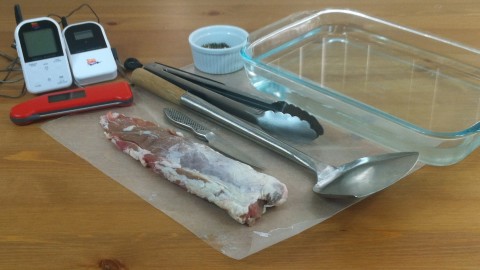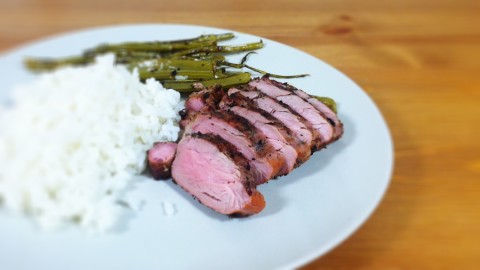Pork chops are the simplest cut to cook, and pork tenderloin comes a close second.
Like the pork chop, the tenderloin comes from the loin primal, but it is even leaner and more tender since it is rarely used (it is the long strip of muscle that runs alongside the rear of the spine).
This means you can make a truly exceptional dish with a cut of tenderloin… but only if you can achieve the daunting task of not overcooking it!
(Longtime readers might know how to do this, but I’ll reveal the secrets later on…)
Instead of using the stove as with the chops, here I used the grill. This was not only to add in a bit of variety, but to address one of the issues of cooking a tenderloin–its size.
The long strip doesn’t really fit in any household-size pan (unless you are a member of the Cyclops family), so tossing it on a big grill grate is often the most practical move.
Ingredients and Equipment
The ingredients you need for grilling a pork tenderloin are even more basic than what you’d need if you cooked in on the stovetop:
- A pork tenderloin (or two)
- A brine for adding flavor and preventing overcooking
- Some pepper or any other spices/herbs/sauces you might want to use to change things up.
And apart from a grill, the equipment you’ll need is quite minimal as well:
- A grill
- A thermometer (or two) to ensure you don’t over- (or under-)cook
- A pair of tongs (and perhaps a long spatula) for flipping the meat
- A knife
The Recipe
Prepare the brine. As I have mentioned before, lean cuts such as those found on the pork loin benefit from brining. It makes them hold onto liquid more readily, and keeps them from overcooking and drying out.
Remove the silverskin. The outside of much of the tenderloin is covered in a milky membrane known as the silverskin, which prevents the brine from penetrating your meat. Using a knife, cut and peel this layer off as much as you can.
Brine your tenderloin and preheat your grill. A soak of about an hour will do. You can (and should) brine your tenderloin up to a few days before you cook to save time if you are cooking during the week.
You want to preheat your grill so that the tenderloin can cook at a low temperature of around 225°F (110°C) to start off.
Coat your tenderloin in pepper. Some good freshly-ground pepper is all you really need, but feel free to change things up with different spices, herbs, and sauces. Tenderloin has a great texture, but not much taste on its own.
Cook the tenderloin slowly at 225°F until it reaches an internal temperature of 125°F (52°C). Insert a probe thermometer (if you have one) into the thickest part of the tenderloin. Otherwise, check that sucker with an instant read thermometer every 5–10 minutes. If you’d like to add some smoke to the mix, now would be the time.
Sear the tenderloin over high heat until it reaches an internal temperature of 140°F (60°C). You may need to take the tenderloin off and add more coal to heat up. This is perfectly fine. You want to scorch the outside to create a Maillard reaction to make a delicious brown crust without overcooking the inside.
Let the meat rest five minutes before serving. Allowing the meat to cool down a bit will allow it to hold onto its juices when you cut into it (rather than spilling them all over your plate). Wait until the temperature reaches 120°F (50°C), or just tear in after five minutes.
Slice the tenderloin up and serve with the veggies of your choice!
The Perfect Weekday Grilled Dinner
Even if you don’t ever buy a whole hog yourself, a pork tenderloin is a great cut of meat to know how to cook.
It’s quick to cook and goes well with any flavorings, which make it incredibly versatile and an excellent choice for those weekday evening grill sessions.
With a couple of basic kitchen hacks (brining and using a thermometer) you can ensure you are always putting a juicy and delicious meal on the table every time!
In upcoming installments, we’ll tackle more of the bits and pieces of a hog that require a little more elbow grease to cook.
Stay tuned!



 I'm a science geek, food lover, and wannabe surfer.
I'm a science geek, food lover, and wannabe surfer.
Comments on this entry are closed.